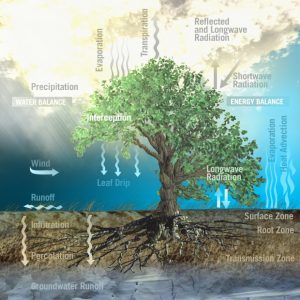5. Water Inputs

The diagram in Fig. 5‑1 will help to guide our systematic study of the processes involved in the soil water balance and subsequently our examination of land surface energy balance process. We will begin with consideration of the process of precipitation, the primary water input to the soil water balance in most environments. We will also briefly consider water inputs through irrigation. From there we will follow the water as it moves through the soil water balance processes, considering in turn:
- interception of water by plant canopies and residue,
- impact of water drops on the soil surface,
- infiltration of water into the soil,
- the processes of runoff and erosion by water,
- then redistribution of water within the soil profile,
- drainage of water from the bottom of the soil profile,
- the associated processes of groundwater pollution and soil salinization,
- then evaporation of water from bare soil surfaces and erosion by wind,
- then root water uptake and transpiration by plants.
When we have completed this overview of the soil water balance processes, we will then consider the closely related processes of the land surface energy balance as shown on the right hand side of Fig. 5‑1.

